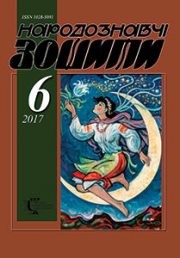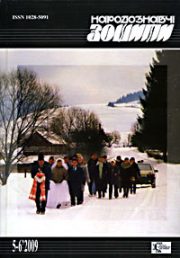The Ethnology Notebooks. 2022. № 4 (166), 949—960
UDK [73.04:726](477.83-25)”20″:821.161.2’373.46
DOI https://doi.org/10.15407/nz2022.04.949
SKOP Mykhailo
- ORCID ID: https://orcid.org/0000-0001-5901-8211
- postgraduate,
- Lviv National Academy of Arts,
- 38, Kubiiovycha Street, 79011, Lviv, Ukraine,
- Contacts: e-mail: neivanmade@gmail.com
Abstract. The article considers a number of terms related to sacred objects of Lviv, in particular, chapels, figures and crosses. The novelty of the topic lies in a comprehensive approach to the problem of differentiation of different types of sacred objects, as well as in an attempt to synthesize into one group a number of terms used by researchers for shrines of different periods, regions and religions.
The aim of the article is to investigate the most common terms and typologies of shrines in public space among Ukrainian and Polish researchers, to identify contradictions, to propose and substantiate the terminology most acceptable for comprehensive and generalized analysis of sacred art in Lviv.
The following methods were used: comparative, cultural context research, method of iconographic analysis, historical and artistic typology and classification. The object of research is sacred art sculptures in the modern public space of Lviv, including chapels, figures and crosses. The subject of the research is the terminology used by Ukrainian and Polish researchers. As a result of the study, the terminology and classifications of a number of scholars were analyzed, differences and contradictions were found and analyzed, in particular in the differentiation of «shrines», «chapels», «figures», «crosses». The dichotomy of «secular» and «sacred» spaces is considered. The use of terms that are most correct for use in relation to sacred objects of Lviv is highlighted and substantiated. A variant of classification by placement is offered.
Keywords: Figure, chapel, roadside cross, sacred sculpture, public space of Lviv, hierotopia, iconography, memorial, altar.
Received 2.08.2022
REFERENCES
- Shcherbakivskyi, D. (1926). Bukovyna and Galicia wooden churches, tombstones and roadside crosses, figures and chapels. Ukrainian art. Kyiv; Prague: Ukrainian Public Publishing Fund [in Ukrainian].
- Onatsky, E. (1959). Chapel. Ukrainian small encyclopedia: in 16 books, 8 vol. (Vol. 3, book V, pp. 596—597). Buenos Aires [in Ukrainian].
- Onatskyi, E. (1959). Way of the Cross. Ukrainian small encyclopedia: 16 books (Vol. 3, book V, p. 2018). Buenos Aires [in Ukrainian].
- Senko, S. (2011). Landscape crosses in Transcarpathia in the 19th and 20th centuries: the process of replacing wood with stone and iron. Scientific Bulletin of Uzhhorod University. Series: History (Issue 27, pp. 143—149) [in Ukrainian].
- Bolyuk, O. (2009). Ukrainian chapels: genesis, types, features. Ukrainian art history: materials, research, reviews (Issue 9, pp. 143—149).Instytut mystetstvoznavstva, fol’klorystyky ta etnolohiyi imeni M.T. Ryl’s’koho NAN Ukrayiny, Kyiv [in Ukrainian].
- Sydor, M. (2014). Reprise of the spiritual concept of Galician roadside chapels in various forms of their architectural expression. Traditions and innovations in higher architectural and artistic education (Issue 2, pp. 114—118) [in Ukrainian].
- Bozhuk, T. (2010). Religious objects in the cultural landscape and their use for the needs of tourism (on the example of the city of Lviv). Scientific notes of Vinnytsia State Pedagogical University named after Mykhailo Kotsiubynskyi. Series: Geography (Issue 21, pp. 9—15) [in Ukrainian].
- Timofienko, V. (2002). Architecture and monumental art: Terms and concepts. Kyiv [in Ukrainian].
- Mozdyr, M. (1997). «Figures» roadside and homestead crosses in Ukraine. Ukrainian Christology: Spec. issue «NZ» (P. 21).Lviv [in Ukrainian].
- Kuzenko, P. (2008). Landscape crosses of Ukraine and Poland: to the question of the interconnection of traditions. Ukrainian-Polish cultural relations (Issue 2, pp. 22—29). Kyiv [in Ukrainian].
- Holly, G. (2012). Wayside crosses and chapels in the Polish-Slovak-Ukrainian borderland. Roczniki Bieszczadzkie, 20, 309—345 [in Polish].
- Mankowski, T. (1974). Old Lviv, it’s art and artistic culture. London [in Polish].
- Lyubchenko, V. (1981). Lviv Sculpture of the XVI—XVII Centuries. Kyiv: Naukova dumka [in Ukrainian].
- Shengera, B. (2020). Lviv sculptors and sculptures of Lviv in the 18th century. Lviv: Lviv National Gallery named after B.G. Voznytskyi [in Ukrainian].
- Gembarovych, M. (1968). Sculpture and carving. History of Ukrainian art: in 6 vol. (Vol. 3: Art of the second half of the 17th—18th centuries) [in Ukrainian].
- Biryulyov, Y. (2015). Lviv sculpture from early classicism to avant-garde (mid 18th — mid-20th centuries). Lviv: Apriori [in Ukrainian].
- Strotsen, L. (2020). Sacred sculpture of Ternopil region (Pp. 2—3).Ternopil: Textbooks and manuals [in Ukrainian].
- Andreychyn, M. (2020). Holy defenders of epidemics and patrons of infectious patients. Sacred sculpture of Ternopil region (Pp. 2—13). Ternopil: Pidruchnyky i posibnyky [in Ukrainian].
- Uniyat-Karpovich, V., & Chepiga, I. (Eds.). (2016). Figures of Ternopil. Ternopil: Terno-graf [in Ukrainian].
- Bykov, O., Burlaka, O., & Kurmaz, S. (2020). Orthodox Chic. Kyiv: Osnovy [in Ukrainian].
- Rуzanska, A., & Kaczynska, M. (2013). Chapels and crosses in the urban landscape of Warsaw. Religious objects in the landscape. Objects of the Cultural Landscape Commission. Committee of the Cultural Landscape PTG, 21, 67—76 [in Polish].
- Zielinska, M. (1991). Shrines of Warsaw. Warsaw: Wydawnictwo Naukowe PWN [in Polish].
- Kalicka, J. (2011). Between the chapel and the garden, between the place and the sign — changes in the funktivanie of backyard shrines in Warsaw. Wayside crosses and chapels as social, cultural and religious memory characters (Pp. 219—227). Lublin: Wydawnictwo Uniwersytetu Marii Curie-Sklodowskiej [in Polish].
- Eliade, M. (2001). Sacred and secular. Mephistopheles and the androgyne. Kyiv: Osnovy [in Ukrainian].
- Lydov, A. (2009). Hierotopia. Spatial icons and images of paradigms in Byzantine culture. Moscow: Troitsa [in Russian].
- Hrybunina, N. (2008). The hierotopia of the New Testament church in the context of Christian cult activity. Voprosy culturologii: Nauchno-prakticheskii i metodicheskii journal, 8, 56—59 [in Russian].
- Kyrychenko, E. (2009). Temple and city. About the content-structural unity of the Russiansacred space. Hierotopia. Comparative studies of sacred spaces (Pp. 292—322). Moscow: Indryk [in Russian].
- Petrukhin, V. (2006). Hierotopia of the Russian land and the initial chronicle. Creation of sacred spaces in Byzantium and Ancient Russia. Moscow [in Russian].
- Lapinski, J. (2018). Sacrum in the country and the sacred landscape. Works of the Cultural Landscape Commission, 39 (1), 41—62 [in Polish].
- Osadcha, O. (2018). Structural and spatial scheme of the Tree of Life in the topographic iconicity of the city-temple-icon-man. All-Ukrainian icon painting conference «Icon Today» (May 5, 2018, Kyiv): collection of scientific papers. Kyiv: National Union of Icon Painters of Ukraine and National Reserve «Sophia Kyivska» [in Ukrainian].
- Sorochuk, A. (2018). Transformation of the sacred space of the medieval city. Bulletin of Lviv University. Physio-political scientist series (Issue 19, pp. 63—69) [in Ukrainian].
- Kostenko, T. (2016). Philosophical and religious analysis of the understanding of the sacred phenomenon in traditional and modern Orthodox theology: autoref. thesis Ph. D. Philos. Sciences: 09.00.11. NPU imeni M.P. Drahomanova. Kyiv [in Ukrainian].
- Nazarova, I. (Ed.). (1978). Dictionary of the Ukrainian language (Vol. 9). Kyiv: Naukova dumka [in Ukrainian].
- Demchuk, R. (2011). Hierotopia and memoriae in the architectural landscape of the city. Scientific notes of NaUKMA. Theory and history of culture (Vol. 114, pp. 34—41)[in Ukrainian].
- Hryshchenko, M. (2016). The public space of the city as an object of sociological research. Bulletin of Taras Shevchenko Kyiv National University. Sociology, 1, 31—38 [in Ukrainian].
- Korol, A. (2012). Theoretical aspects of plastic arts classification. Youth and the market, 1, 141—146 [in Ukrainian].
- Pasichniy, A. (2008). Fine art. Ternopil: Navchalna knyha; Bohdan [in Ukrainian].
- Shevnyuk, O. (2015). Dictionary of fine art terms: Education. Manual. Kyiv: NPU named after M.P. Drahomanova [in Ukrainian].
- Kowalski, J.W. (1987). The world of monks and orders. Warsaw: National Publishing Agency (P. 132) [in Polish].
- Tokarski, J. (Ed.). (1980). PWN dictionary of foreign words. Warsaw: State Scientific Publishers (P. 339) [in Polish].
- Zavada, V. (2017). Wooden chapels: between paganism and Christianity. Modern problems of architecture and urban planning (Issue 49, pp. 414—425) [in Ukrainian].
- Dyba, Y. (2006). Architectural prototypes of iconographic images of «kumyrnitsa» of the XV—XVII centuries. Studiyi mystetstvoznavchi, 3, 51—61 [in Ukrainian].
- Bilodid, I. (Ed.). (1970—1980). Dictionary of the Ukrainian language: in 11 vol.(Vol. 4, p. 95). Academy of Sciences of the Ukrainian SSR Institute of Linguistics. Kyiv: Naukowa dumka [in Ukrainian].
- Klodnicki, Z. (2011). Sacrificial signs in the past. An attempt at typology and assigning (geography) of individual varieties of shrines in Poland. The cross and wayside shrines as signs of the cultural and religious social memory (Pp. 14—15). Lublin [in Polish].
- Seweryn, T. (1958). Wayside shrines and crosses in Poland. Warsaw: Instytut Wydawniczy PAX [in Polish].
- (1996). Terminological dictionary of fine arts. Warszawa: PWN [in Polish].
- Czechowicz, B. (2002). Wayside shrine. Religion. PWN Encyclopedia (Vol. 5, pp. 356—357). Warsaw: Wydawnictwo Naukowe PWN [in Polish].
- Kuczowic, J. Shrine Encyclopedia. Retrieved from: https://przydrozne.eu/pages/intro-encyclopedia.html [in Polish].
- Rydzewska, A., & Wilaniemc, A. (2013). Chapels and crosses in the open and urbanized landscape of Wielkopolska. Religious objects in the landscape. Works of the Cultural Landscape Commission. Committee of the Cultural Landscape PTG, 21, 89—102 [in Polish].
- Wolk, A. (2015). The sacred sphere in the urban passage — the chapels of Warsaw’s Praga. University Sociological Journal, 13 (4), 57—71 [in Polish].
- (1990). Tale of the ancient years: chronicle. Kyiv: Radyans’kyy Pys’mennyk [in Polish].
- Bazhan, M.P., & Aseev, Y.S. (Eds.). (1966). History of Ukrainian art: in 6 vol. Art of the earliest times and era of Kyivan Rus (Vol. 1). Kyiv: Academy of Sciences of the Ukrainian SSR [in Ukrainian].
- Ignatenko, I., & Nagornyuk, O. (2013).Roadside crosses of Polissia: functions, semantics and symbolism. The Ethnology Notebooks, 1, 99—104 [in Ukrainian].







